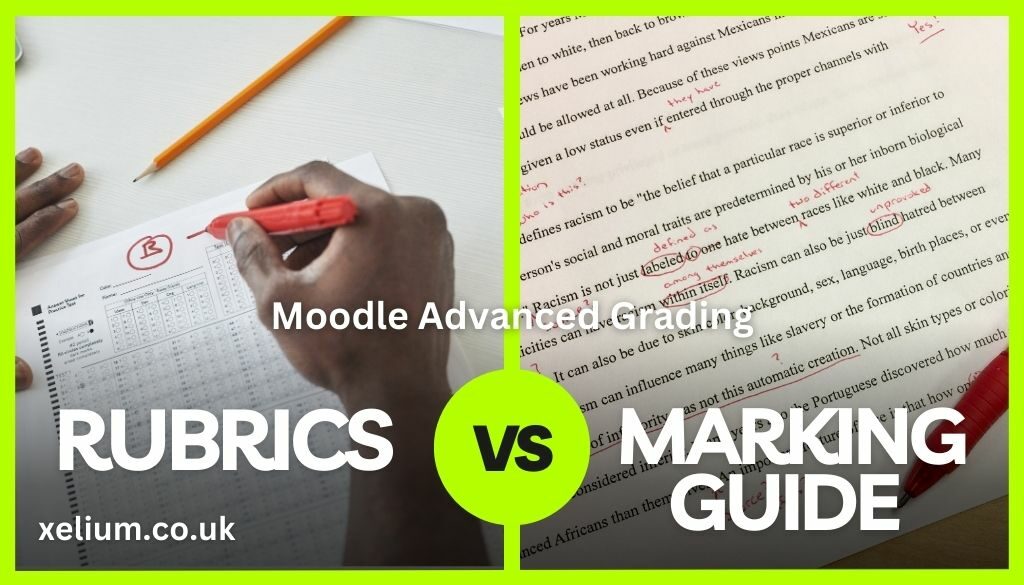How to Choose the Right Tool for Advanced Grading in Moodle: Rubrics vs. Marking Guides
Effective assessment strategies are key to providing meaningful feedback and allowing students to learn effectively and reflectively. While assessment techniques have long relied on time-consuming individual personal feedback, with the availability of advanced grading, instructors can now optimise marking and personalised feedback. A core set of key feedback can be programmed for instructors to pick and choose from and further comment spaces can made available for even more detailed and personalised individual feedback.
Rubrics vs. Marking Schemes in Moodle: Choosing the Right Tool for Advanced Grading
Moodle offers two powerful tools for advanced grading: Rubrics and Marking Guides. Both of these tools serve to standardise grading, enhance transparency, and support students in understanding the criteria by which they are assessed. However, they serve different purposes and are best used in different scenarios. This post will compare Rubrics and Marking Schemes, and provide detailed examples to illustrate their use cases.
Understanding Rubrics
A Rubric is a matrix that outlines specific criteria and levels of achievement for each criterion. It allows for grading based on a range of performance levels, providing detailed feedback on different aspects of the assignment. Each criterion is assessed on a scale (e.g., from “Excellent” to “Needs Improvement”), and each level is associated with a specific score or range of scores.
When to Use Rubrics
Rubrics are ideal when you want to:
- Assess multiple aspects of an assignment: For instance, if a student submits an essay, you might want to grade it based on structure, argumentation, grammar, and originality.
- Provide detailed feedback: Rubrics allow you to communicate specific strengths and areas for improvement across various dimensions of the assignment.
- Maintain consistency: When multiple graders are involved, Rubrics help ensure that each student is evaluated using the same criteria, thus reducing subjectivity.
Example of a Rubric
Consider an assignment where students must write a research paper. A Rubric for this assignment might include criteria such as:
Introduction and Thesis Statement
- Excellent (5 points): Clear, engaging introduction with a well-defined thesis.
- Good (4 points): Clear introduction, thesis is present but could be more defined.
- Satisfactory (3 points): Introduction is present but lacks clarity or engagement; thesis is vague.
- Needs Improvement (2 points): Introduction is unclear, and the thesis is poorly defined.
- Unsatisfactory (1 point): Introduction is missing or does not contain a thesis.
Argumentation and Evidence
- Excellent (5 points): Arguments are well-developed and supported with strong, relevant evidence.
- Good (4 points): Arguments are clear but could be better supported by evidence.
- Satisfactory (3 points): Arguments are present but lack depth or adequate support.
- Needs Improvement (2 points): Arguments are weak, and evidence is lacking or irrelevant.
- Unsatisfactory (1 point): No clear arguments or supporting evidence.
Grammar and Style
- Excellent (5 points): Writing is free of grammatical errors and has a professional tone.
- Good (4 points): Minor grammatical errors, but they do not detract from the overall quality.
- Satisfactory (3 points): Noticeable errors that occasionally affect readability.
- Needs Improvement (2 points): Frequent errors that significantly hinder comprehension.
- Unsatisfactory (1 point): Writing is riddled with errors, making it difficult to understand.
Each level within a criterion has a specific point value, which allows for detailed feedback and precise grading. The total score is calculated based on the sum of points from all criteria.
For comparison, we will now look at the Marking Guide and what it can be used for.
Understanding Marking Guide
A Marking Guide, is a simpler, more flexible tool compared to a Rubric. It consists of a list of criteria with corresponding descriptions of what is expected for each criterion. Rather than having multiple levels of performance, each criterion in a Marking Guide is typically evaluated holistically, with the instructor assigning a score within a defined range.
When to Use Marking Schemes
Marking Schemes are ideal when you want to:
- Simplify grading: If the assignment requires a more holistic assessment, the Marking Guide allows for broader evaluation without the need to break down each criterion into multiple levels.
- Encourage grader discretion: Marking Guides give graders more flexibility in assigning scores based on overall impressions and qualitative judgments.
- Streamline the grading process: For assignments where detailed feedback is less critical, or where the assignment is more straightforward, a Marking Guide can make the grading process faster and more efficient.
Example of a Marking Guide
Let’s consider a presentation assignment. A Marking Guide for this assignment might include the following criteria:
Content and Understanding
Maximum Points: 20
“The presentation demonstrates a thorough understanding of the topic, with clear, well-organized content that effectively communicates key points.”
Delivery and Engagement
Maximum Points: 15
“The presenter speaks clearly, maintains eye contact, and engages the audience throughout the presentation.”
Use of Visual Aids
Maximum Points: 10
“Visual aids are well-designed, relevant, and enhance the overall presentation without distracting from the speaker.”
For each criterion, the instructor would assign a score based on their holistic judgment, with the total grade being the sum of all the points awarded. A more detailed marks breakdown can be assigned within the Marking Guide against a range of different criterion.
Comparison of Use Scenarios: when to use Rubrics and when to use Marking Guide
Complexity and Detail: Rubrics are more detailed and structured, making them suitable for complex assignments where multiple aspects need to be evaluated separately. Marking Guides are less detailed and more flexible, ideal for assignments that can be assessed with broader criteria.
Feedback Precision: Rubrics provide more granular feedback, as students can see exactly where they excelled and where they need improvement. Marking Guides offer less detailed feedback, focusing instead on overall performance in each area. However both allow spaces for comments and further feedback.
Grading Consistency: Rubrics help ensure consistent grading, especially useful in large classes or when multiple graders are involved. Marking Guides rely more on the grader’s discretion, which can be beneficial in smaller, more subjective assessments. In cases where the grader or teacher has to judge based on their own experience or professional experience, a Marking Guide provides a looser, broader approach.
Time and Efficiency: While Rubrics take more time to create and use, they offer the benefit of clear, consistent grading criteria. Marking Guides can be quicker to set up and apply, making them suitable for assignments where speed and flexibility are priorities.
How to Choose Between Rubrics and Marking Schemes
When deciding whether to use a Rubric or a Marking Scheme for your Moodle assessments, consider the following questions:
1. What is the complexity of the assignment?
Rubric: If the assignment involves multiple components (e.g., content quality, structure, creativity) that need to be evaluated separately, a Rubric is ideal. It allows you to break down the assignment into specific criteria, providing detailed, criterion-based feedback.
Marking Guide: For simpler assignments where a holistic evaluation is sufficient, a Marking Guide may be more appropriate.
2. How detailed does your feedback need to be?
Rubric: If your students benefit from seeing exactly where they excel and where they need improvement across different levels of performance, a Rubric is the best choice. It provides structured, detailed feedback.
Marking Guide: If general feedback that focuses on overall performance is sufficient, a Marking Scheme would be more efficient.
3. What is your grading process like?
Rubric: When grading a large number of students or if multiple graders are involved, a Rubric ensures consistency and objectivity. It standardizes the grading process, making it easier to maintain fairness.
Marking Guide: If grading is done by a single instructor or if the assignment is less complex, a Marking Guide offers more flexibility and allows for grader discretion.
4. How much time do you have for grading?
Rubric: If you have the time to create and apply a detailed Rubric, it can provide more precise and structured feedback. However, be mindful that Rubrics take longer to develop and use.
Marking Guide: If time is a constraint and you need to expedite the grading process, a Marking Guide is quicker to set up and apply while still providing meaningful feedback.
5. What is the nature of the assignment?
Rubric: For assignments that require precise evaluation of specific skills or knowledge areas (e.g., a research paper, technical report), a Rubric is more appropriate as it allows for detailed assessment.
Marking Guide: For more subjective assignments that require holistic judgment (e.g., a creative project or presentation), a Marking Guide may be more suitable.
6. How familiar are students with the grading criteria?
Rubric: If students need clear, transparent guidelines on how their work will be evaluated, a Rubric provides this clarity. It explicitly outlines what is expected at each performance level.
Marking Guide: If students are already familiar with the expectations or if the assignment is straightforward, a Marking Guide can suffice.
7. What are your learning objectives?
Rubric: If your goal is to develop specific skills that need to be clearly communicated and measured, a Rubric is ideal. It aligns well with objectives that require detailed, criterion-based assessment.
Marking Guide: If your focus is on encouraging overall understanding and application of concepts, a Marking Guide may be more aligned with your objectives. It allows for broader, more flexible evaluation.
These guided responses will hopefully help you choose the most appropriate grading method based on the specific needs of the type of assignments, grading requirements and learning objectives. ensuring that their choice supports both effective assessment and student learning.
Conclusion
Both Rubrics and Marking Guides are powerful tools in Moodle’s Advanced Grading arsenal. The choice between them depends on the nature of the assignment, the level of feedback you want to provide, and the need for grading consistency. By understanding the strengths and ideal use cases of each, you can select the most appropriate tool to enhance the assessment process, provide meaningful feedback, and support effective student learning.
By leveraging these advanced grading tools effectively, educators can streamline their grading process and enhance the clarity and impact of their feedback, ultimately contributing to a richer, more meaningful learning experience for students.
Related post: How to use Advanced Grading – Custom Marking Guide (Mark Scheme) for Assignment in Moodle

